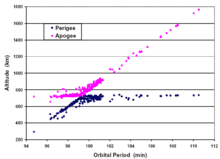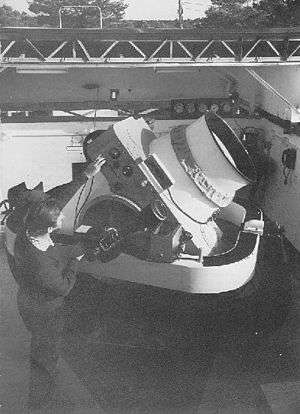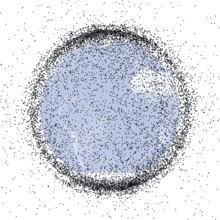Kessler syndrome
The Kessler syndrome (also called the Kessler effect,[1][2] collisional cascading, or ablation cascade), proposed by NASA scientist Donald J. Kessler in 1978, is a theoretical scenario in which the density of objects in low Earth orbit (LEO) due to space pollution is high enough that collisions between objects could cause a cascade in which each collision generates space debris that increases the likelihood of further collisions.[3] One implication is that the distribution of debris in orbit could render space activities and the use of satellites in specific orbital ranges difficult for many generations.[3]

History of the science behind the Kessler syndrome
NORAD, Gabbard and Kessler
Willy Ley predicted in 1960 that "In time, a number of such accidentally too-lucky shots will accumulate in space and will have to be removed when the era of manned space flight arrives".[4] After the launch of Sputnik 1 in 1957, the North American Aerospace Defense Command (NORAD) began compiling a database (the Space Object Catalog) of all known rocket launches and objects reaching orbit: satellites, protective shields and upper- and lower-stage booster rockets. NASA later published modified versions of the database in two-line element set,[5] and during the early 1980s the CelesTrak bulletin board system re-published them.[6]

The trackers who fed the database were aware of other objects in orbit, many of which were the result of in-orbit explosions.[7] Some were deliberately caused during the 1960s anti-satellite weapon (ASAT) testing, and others were the result of rocket stages blowing up in orbit as leftover propellant expanded and ruptured their tanks. To improve tracking, NORAD employee John Gabbard kept a separate database. Studying the explosions, Gabbard developed a technique for predicting the orbital paths of their products, and Gabbard diagrams (or plots) are now widely used. These studies were used to improve the modeling of orbital evolution and decay.[8]
When the NORAD database became publicly available during the 1970s, NASA scientist Donald J. Kessler applied the technique developed for the asteroid-belt study to the database of known objects. In 1978, Kessler and Burton Cour-Palais co-authored "Collision Frequency of Artificial Satellites: The Creation of a Debris Belt",[9] demonstrating that the process controlling asteroid evolution would cause a similar collision process in LEO in decades rather than billions of years. They concluded that by about 2000, space debris would outpace micrometeoroids as the primary ablative risk to orbiting spacecraft.[10]
At the time, it was widely thought that drag from the upper atmosphere would de-orbit debris faster than it was created. However, Gabbard was aware that the number and type of objects in space were under-represented in the NORAD data and was familiar with its behavior. In an interview shortly after the publication of Kessler's paper, Gabbard coined the term Kessler syndrome to refer to the accumulation of debris;[10] it became widely used after its appearance in a 1982 Popular Science article,[11] which won the Aviation-Space Writers Association 1982 National Journalism Award.[10]
Follow-up studies

The lack of hard data about space debris prompted a series of studies to better characterize the LEO environment. In October 1979, NASA provided Kessler with funding for further studies.[10] Several approaches were used by these studies.
Optical telescopes or short-wavelength radar was used to measure the number and size of space objects, and these measurements demonstrated that the published population count was at least 50% too low.[12] Before this, it was believed that the NORAD database accounted for the majority of large objects in orbit. Some objects (typically, US military spacecraft) were found to be omitted from the NORAD list, and others were not included because they were considered unimportant. The list could not easily account for objects under 20 cm (7.9 in) in size—in particular, debris from exploding rocket stages and several 1960s anti-satellite tests.[10]
Returned spacecraft were microscopically examined for small impacts, and sections of Skylab and the Apollo Command/Service Module which were recovered were found to be pitted. Each study indicated that the debris flux was higher than expected and debris was the primary source of micrometeoroids and orbital debris collisions in space. LEO already demonstrated the Kessler syndrome.[10]
In 1978, Kessler found that 42 percent of cataloged debris was the result of 19 events, primarily explosions of spent rocket stages (especially US Delta rockets).[13] He discovered this by first identifying those launches that were described as having a large number of objects associated with a payload, then researching the literature to determine the rockets used in the launch. In 1979, this finding resulted in establishment of the NASA Orbital Debris Program after a briefing to NASA senior management, overturning the previously held belief that most unknown debris was from old ASAT tests, not from US upper stage rocket explosions that could seemingly be easily managed by depleting the unused fuel from the upper stage Delta rocket following the payload injection. Beginning in 1986, when it was discovered that other international agencies were possibly experiencing the same type of problem, NASA expanded its program to include international agencies, the first being the European Space Agency.[14]:2 A number of other Delta components in orbit (Delta was a workhorse of the US space program) had not yet exploded.
A new Kessler syndrome
During the 1980s, the US Air Force (USAF) conducted an experimental program to determine what would happen if debris collided with satellites or other debris. The study demonstrated that the process differed from micrometeoroid collisions, with large chunks of debris created which would become collision threats.[10]
In 1991, Kessler published "Collisional cascading: The limits of population growth in low Earth orbit"[15] with the best data then available. Citing the USAF conclusions about creation of debris, he wrote that although almost all debris objects (such as paint flecks) were lightweight, most of its mass was in debris about 1 kg (2.2 lb) or heavier. This mass could destroy a spacecraft on impact, creating more debris in the critical-mass area.[16] According to the National Academy of Sciences:
A 1-kg object impacting at 10 km/s, for example, is probably capable of catastrophically breaking up a 1,000-kg spacecraft if it strikes a high-density element in the spacecraft. In such a breakup, numerous fragments larger than 1 kg would be created.[17]
Kessler's analysis divided the problem into three parts. With a low-enough density, the addition of debris by impacts is slower than their decay rate and the problem is not significant. Beyond that is a critical density, where additional debris leads to additional collisions. At densities beyond this critical mass production exceeds decay, leading to a cascading chain reaction reducing the orbiting population to small objects (several centimeters in size) and increasing the hazard of space activity.[16] This chain reaction is known as the Kessler syndrome.[10]
In an early 2009 historical overview, Kessler summed up the situation:
Aggressive space activities without adequate safeguards could significantly shorten the time between collisions and produce an intolerable hazard to future spacecraft. Some of the most environmentally dangerous activities in space include large constellations such as those initially proposed by the Strategic Defense Initiative in the mid-1980s, large structures such as those considered in the late-1970s for building solar power stations in Earth orbit, and anti-satellite warfare using systems tested by the USSR, the US, and China over the past 30 years. Such aggressive activities could set up a situation where a single satellite failure could lead to cascading failures of many satellites in a period much shorter than years.[10]
Debris generation and destruction
Every satellite, space probe, and crewed mission has the potential to produce space debris. The theoretical cascading Kessler syndrome becomes more likely as satellites in orbit increase in number. As of 2014, there were about 2,000 commercial and government satellites orbiting the earth.[18] It is estimated that there are 600,000 pieces of space junk ranging from 1 to 10 cm (0.39 to 3.94 in), and on average one satellite is destroyed each year.[18][19]
The most commonly used orbits for both manned and unmanned space vehicles are low Earth orbits, which cover an altitude range low enough for residual atmospheric drag to be sufficient to help keep the zone clear. Collisions that occur in this altitude range are also less of an issue because the directions into which the fragments fly and/or their lower specific energy often result in orbits intersecting with Earth or having perigee below this altitude.
Orbital decay is much slower at altitudes where atmospheric drag is insignificant. Slight atmospheric drag, lunar perturbation, and solar wind drag can gradually bring debris down to lower altitudes where fragments finally re-enter, but this process can take millennia at very high altitudes.
Implications

The Kessler syndrome is troublesome because of the domino effect and feedback runaway wherein impacts between objects of sizable mass spall off debris from the force of the collision. The fragments can then hit other objects, producing even more space debris: if a large enough collision or explosion were to occur, such as between a space station and a defunct satellite, or as the result of hostile actions in space, then the resulting debris cascade could make prospects for long-term viability of satellites in particular low Earth orbits extremely low.[20][21] However, even a catastrophic Kessler scenario at LEO would pose minimal risk for launches continuing past LEO, or satellites travelling at medium Earth orbit (MEO) or geosynchronous orbit (GEO). The catastrophic scenarios predict an increase in the number of collisions per year, as opposed to a physically impassable barrier to space exploration that occurs in higher orbits.
Avoidance and reduction
Designers of a new vehicle or satellite are frequently required to demonstrate that it can be safely disposed of at the end of its life, for example by use of a controlled atmospheric reentry system or a boost into a graveyard orbit.[22] For US launches or satellites that will have broadcast to US territories—in order to obtain a license to provide telecommunications services in the United States—the Federal Communications Commission (FCC) required all geostationary satellites launched after 18 March 2002 to commit to moving to a graveyard orbit at the end of their operational life.[22] US government regulations similarly require a plan to dispose of satellites after the end of their mission: atmospheric re-entry, movement to a storage orbit, or direct retrieval.[23]
A proposed energy-efficient means of deorbiting a spacecraft from MEO is to shift it to an orbit in an unstable resonance with the Sun or Moon that speeds up orbital decay.[24][25]
One technology proposed to help deal with fragments from 1 to 10 cm (0.39 to 3.94 in) in size is the laser broom, a proposed multimegawatt land-based laser that could deorbit debris: the side of the debris hit by the laser would ablate and create a thrust that would change the eccentricity of the remains of the fragment until it would re-enter harmlessly.[26]
Potential trigger
The Envisat satellite is a large, inactive satellite with a mass of 8,211 kg (18,102 lb) that drifts at 785 km (488 mi), an altitude where the debris environment is the greatest—two catalogued objects can be expected to pass within about 200 m (660 ft) of Envisat every year[27]—and likely to increase. Don Kessler predicted in 2012 that it could easily become a major debris contributor from a collision during the next 150 years that it will remain in orbit.[27]
In fiction
- In Peter F. Hamilton's 2001 novel Fallen Dragon, the residents of the planet Santa Chico deliberately set off a Kessler syndrome in order to "close the sky" from marauding spaceships, making further trips to or from the planet impossible.
- The initial segment of the 2003 manga Planetes is centered around an orbital debris cleaning crew, whose entire purpose is reducing the Kessler risk.
- The 2013 film Gravity features a Kessler syndrome catastrophe as the inciting incident of the story, when the Russians shoot down an old satellite.[28]
- Neal Stephenson's 2015 novel Seveneves begins with the unexplained explosion of the Moon into seven large pieces, the subsequent creation of a cloud of debris by Kessler syndrome collisions, and the eventual bombardment of Earth's surface by lunar meteoroids.[29]
- In Marc Cameron's 2018 novel Tom Clancy: Oath of Office, Iranian dissidents plot to shoot two Russian nuclear missiles into space to destroy an orbiting satellite which would then set off the Kessler Syndrome.
- The 2019 video game Ace Combat 7: Skies Unknown features Erusea firing Anti-Satellite Missiles at Osean satellites, only for Osea to follow suit. This inevitably leads to Kessler Syndrome which plunges the continent of Usea into widespread chaos.
See also
- 1961 and 1963 Project West Ford – Experimental space-based radio communication project
- 1985 ASM-135 ASAT anti-satellite missile test
- 2007 Chinese anti-satellite missile test
- 2009 satellite collision – 2009 collision between the Iridium 33 and Cosmos-2251 satellites
- P78-1
- SNAP-10A – Experimental nuclear-powered US Air Force satellite
- Space Liability Convention
- USA-193
References
- Stenger, Richard (2002-05-03). "Scientist: Space weapons pose debris threat". CNN.com. Archived from the original on 2012-09-30. Retrieved 2011-03-17.
- Olson, Steve (July 1998). "The Danger of Space Junk – 98.07". The Atlantic. Retrieved 2020-06-18 – via TheAtlantic.com.
- Kessler, Donald J.; Cour-Palais, Burton G. (1978). "Collision Frequency of Artificial Satellites: The Creation of a Debris Belt". Journal of Geophysical Research. 83: 2637–2646. Bibcode:1978JGR....83.2637K. doi:10.1029/JA083iA06p02637.
- Ley, Willy (August 1960). "How to Slay Dragons". For Your Information. Galaxy Science Fiction. pp. 57–72.
- Hoots, Felix; Schumacher, Paul Jr.; Glover, Robert (2004). "History of Analytical Orbit Modeling in the U.S. Space Surveillance System". Journal of Guidance Control and Dynamics. 27 (2): 174–185. Bibcode:2004JGCD...27..174H. doi:10.2514/1.9161.
- Kelso, T. S. "Historical Archives". CelesTrak BBS. Archived from the original on 17 July 2012., 2-line elements dating to 1980.
- Schefter, p. 48.
- Portree, David; Loftus, Joseph (1999). "Orbital Debris: A Chronology" (PDF). NASA. p. 13. Archived from the original (PDF) on 1 September 2000.
- Kessler 1978
- Kessler, Donald J. (8 March 2009). "The Kessler Syndrome". Archived from the original on 27 May 2010. Retrieved 22 September 2009.
- Schefter
- Kessler 1991, p. 65.
- Kessler 1981
- Klinkrad, Heiner (2006). Space Debris: Models and Risk Analysis. Springer-Praxis. ISBN 3-540-25448-X.
- "pdf of article" (PDF). Archived (PDF) from the original on 14 August 2018. Retrieved 14 August 2018.
- Kessler 1991, p. 63.
- Orbital Debris, a Technical Assessment. Washington, D.C.: National Academy Press. 1995. p. 4. ISBN 0-309-05125-8.
- "Lockheed Martin in space junk deal with Australian firm". BBC News. 28 August 2014. Retrieved 2014-08-28.
- Carpineti, Alfredo (2016-05-15). "Space Debris Has Chipped One Of The ISS's Windows". I Fucking Love Science. Archived from the original on 2016-05-16. Retrieved 2016-05-16.
- Primack, Joel R. (2002). "Debris and Future Space Activities" (PDF). physics.ucsc.edu. Physics Department, University of California, Santa Cruz.
With enough orbiting debris, pieces will begin to hit other pieces, setting off a chain reaction of destruction that will leave a lethal halo around the Earth.
- Primack, Joel R.; Abrams, Nancy Ellen. "Star Wars Forever? – A Cosmic Perspective" (PDF). physics.ucsc.edu. Physics Department, University of California, Santa Cruz.
the deliberate injection into LEO of large numbers of particles as a cheap but effective anti-satellite measure.
- "FCC Enters Orbital Debris Debate". Archived from the original on 2008-05-06.
- "US Government Orbital Debris Standard Practices" (PDF).
- Witze, A. (2018-09-05). "The quest to conquer Earth's space junk problem". Nature. 561 (7721): 24–26. Bibcode:2018Natur.561...24W. doi:10.1038/d41586-018-06170-1. PMID 30185967.
- Daquin, J.; Rosengren, A. J.; Alessi, E. M.; Deleflie, F.; Valsecchi, G. B.; Rossi, A. (2016). "The dynamical structure of the MEO region: long-term stability, chaos, and transport". Celestial Mechanics and Dynamical Astronomy. 124 (4): 335–366. arXiv:1507.06170. Bibcode:2016CeMDA.124..335D. doi:10.1007/s10569-015-9665-9.
- "NASA Hopes Laser Broom Will Help Clean Up Space Debris". SpaceDaily.com. Retrieved 2011-03-17.
- Gini, Andrea (25 April 2012). "Don Kessler on Envisat and the Kessler Syndrome". Space Safety Magazine. Retrieved 2012-05-09.
- Sinha-Roy, Piya (July 20, 2013). "Gravity gets lift at Comic-Con as director Cuaron leaps into space". Reuters. Retrieved 2013-09-05.
- Freeman, Daniel (18 May 2015). "Neal Stephenson's Seveneves – A Low-Spoiler "Science" Review". Berkeley Science Review. Retrieved 4 August 2015.
Further reading
- Kessler, D (2009). "The Kessler Syndrome (As Discussed by Donald J. Kessler)". Archived from the original on 2010-05-27. Retrieved 2010-05-26.
- An article in the July 2009 issue of Popular Mechanics by Glenn Harlan Reynolds discusses the Kessler syndrome in regards to the February 2009 satellite collision and how international law may need to address the problem to help prevent future incidents: Reynolds, G. H. (2009, July). "Collision course". Popular Mechanics, pp. 50–52.
- Documentary: Collision point: The race to clean up space (length: 22 minutes 28 seconds), included in the extra material on the Blu-ray Disc for Gravity (film).
External links
- Donald Kessler's Web Page at uwo.ca
- Orbiting Satellites in real time at stuffin.space
- NASA Astronomy Picture of the Day: Satellites Collide in Low Earth Orbit (18 February 2009)
- Mathematical Modeling of debris flux at lasp.colorado.edu
- "Orbiting Junk, Once a Nuisance, Is Now a Threat". The New York Times.
- "Houston we have a trash problem". Wired.
- Schwartz, Evan I. (May 24, 2010). "The Looming Space Junk Crisis: It's Time to Take Out the Trash". Wired. Retrieved 14 June 2010.
- "Debris Spews Into Space After Satellites Collide". The New York Times.
- Aggregated public information research on space debris, graveyard orbits, etc.
- "Space junk littering orbit; might need cleaning up". Associated Press. 1 September 2011.